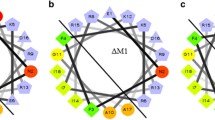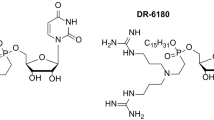Abstract
Tachyplesin I, a broad-spectrum antimicrobial peptide fromTachypleus tridentatus has a basic (+7), amphiphilic, and cyclic β-sheet structure. We reported (Matsuzaki K. et al. (1991) Biochim. Biophys. Acta 1070:259–264) that 1) the action mechanism of tachyplesin I may be the permeabilization of bacterial membranes, 2) the peptide specifically permeabilizes acidic phospholipid bilayers, and 3) its Trp2 residue is located in the hydrophobic region near the surface of the bilayers. In this paper, we found that tachyplesin I dose-dependently induces not only the permeabilization but also aggregation/fusion and micellization of the phosphatidylglycerol large unilamellar vesicles (100 nm in diameter) either in the gel (L-α-dipalmitoylphosphatidyl-DL-glycerol (DPPG)) or liquid-crystalline (egg yolk L-α-phosphatidyl-DL-glycerol (egg PG)) phase, as revealed by light scattering and electron micrograph techniques. The solid DPPG vesicles were more susceptible to the peptide. At peptide to lipid molar ratios (P/L) of 1/500 to 1/200, interpeptide interactions formed a pore through which calcein, a fluorescent dye, can leak out of the vesicles. The pore lifetime was longer in the DPPG vesicles. Further addition of the peptide caused aggregation and/or fusion of the vesicles. At a charge-neutralizingP/L ratio of 1/7, the enlarged vesicles disintegrated into small spherical particles (10–20 nm in diameter). The mechanism for these morphological changes will be discussed.
Similar content being viewed by others
References
Dufourcq J, Faucon J-F, Fourche G, Dasseux J-L, Maire ML, Gulik-Krzywicki T (1986) Biochim Biophys Acta 859:33–48
Dufourc EJ, Smith ICP, Dufourcq J (1986) Biochemistry 25:6448–6455
Morgan CG, Williamson H, Fuller S, Hudson B (1983) Biochim Biophys Acta 732:668–674
Batenburg AM, Hibbeln JCL, Verkleij AJ, De Kruijff B (1987) Biochim Biophys Acta 903:142–154
Zidovetzki R, Banerjee U, Harrington W, Chan SI (1988) Biochemistry 27:5686–5692
Pache W, Chapman D, Hillby R (1972) Biochim Biophys Acta 255:358–364
Eytan G D, Broza R, Shalitin Y (1988) Biochim Biophys Acta 937:387–397
Kubesch P, Boggs J, Luciano L, Maass G, Tümmler B (1987) Biochemistry 26:2139–2149
Dufourc EJ, Dufourcq J, Birkbeck TH, Freer JH (1990) Eur J Biochem 187:581–587
Epand RM, Gawish A, Iqbal M, Gupta KB, Chen CH, Segrest JP, Anantharamaiah GM (1987) J Biol Chem 262:9389–9396
Akaji K, Fujii N, Tokunaga F, Miyata T, Iwanaga S, Yajima H (1989) Chem Pharm Bull 37:2661–2664
Nakamura T, Furunaka H, Miyata T, Tokunaga F, Muta T, Iwanaga S (1988) J Biol Chem 263:16709–16713
Miyata T, Tokunaga F, Yoneya T, Yoshikawa K, Iwanaga S, Niwa M, Takano T, Shimonishi Y (1989) J Biochem 106:663–668
Kawano K, Yoneya T, Miyata T, Yoshikawa K, Tokunaga F, Terada Y, Iwanaga S (1990) J Biol Chem 265:15365–15367
Kawano K, Yoneya T, Miyata T, Yoshikawa K, Tokunaga F, Terada Y, Iwanaga S (1991) In: Shimonishi Y (ed) Peptide chemistry 1990. Protein Research Foundation, Osaka, pp 385–388
Matsuzaki K, Fukui M, Fujii N, Miyajima K (1991) Biochim Biophys Acta 1070:259–264
Hope MJ, Bally MB, Webb G, Cullis PR (1985) Biochim Biophys Acta 812:55–65
Matsuzaki K, Takaishi Y, Fujita T, Miyajima K (1991) Colloid Polym Sci 269:604–611
Bartlett GR (1959) J Biol Chem 234:466–468
Allen TM, Cleland LG (1980) Biochim Biophys Acta 597:418–426
Johonson SM, Bangham AD, Hill MW, Korn ED (1971) Biochim Biophys Acta 233:820–826
Matsuzaki K, Nakai S, Handa T, Takaishi Y, Fujita T, Miyajima K (1989) Biochemistry 28:9392–9398
Schwarz G, Robert CH (1990) Biophys J 58:577–583
Gregoriadis G (ed) (1984) Liposome technology, Vol 3. CRC Press Inc, Florida, pp 193–195
Stacey KA (1956) Light-scattering in physical chemistry. Butterworths Scientific Publications, London, chapter 2
Struck DK, Hoekstra D, Pagano RE (1981) Biochemistry 20:4093–4099
Nagawa Y, Regan SL (1991) Membrane Symposium 3:80–83
Ohki S (1988) In: Ohki S, Doyle D, Flangan TD, Hui SW, Mayhew E (eds) Molecular mechanisms of membrane fusion. Plenum Press, New York, pp 123–138
Walter A, Steer CJ, Blumenthal R (1986) Biochem Biophys Acta 861:319–330
Lafleur M, Samson I, Pézdet M (1991) Chem Phys Lipids 59:233–244
Author information
Authors and Affiliations
Rights and permissions
About this article
Cite this article
Matsuzaki, K., Fukui, M., Fujii, N. et al. Permeabilization and morphological changes in phosphatidylglycerol bilayers induced by an antimicrobial peptide, tachyplesin I. Colloid Polym Sci 271, 901–908 (1993). https://doi.org/10.1007/BF00652773
Received:
Accepted:
Issue Date:
DOI: https://doi.org/10.1007/BF00652773




